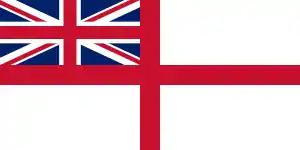Lord High Admiral of the United Kingdom
The Lord High Admiral (of England, Great Britain and then the United Kingdom, beginning in the 14th century)[1] is the titular head of the Royal Navy. Most have been courtiers or members of the Royal Family, and not professional naval officers. The office of Lord High Admiral is one of the nine English Great Officers of State.
| Lord High Admiral of the United Kingdom | |
|---|---|
 Flag of the Lord High Admiral | |
| Appointer | Monarch |
| Formation | 22 February 1385 |
| First holder | The Earl of Arundel |
| Deputy | Vice-Admiral of the United Kingdom |
History
The office was created in England late 14th century sometime between 1405/06 and 1412 the two existing older naval commands that of the Admiral of the North and Admiral of the West were unified with this office.[2]
During the reign of Henry VIII (1509–47) the English Navy had expanded to a point where it could not be managed by a single Lord High Admiral alone, therefore day-to-day management of the navy was handed over to a committee that later became known as the Navy Board. The navy board had Samuel Pepys as one of its members during the reign of Charles II (1660–85), and it ran side-by-side with the Board of Admiralty.[3]
From the early 17th century onwards, when an individual Lord High Admiral was appointed, there was also a Council of the Lord High Admiral which assisted him to perform some of the duties of the Admiralty. When this office was not occupied by an individual, it was "put into commission" and exercised by a Board of Admiralty headed by a First Lord of the Admiralty; this was the usual arrangement from 1709 until it was merged with the Admiralty in 1832.
However, the office of Lord High Admiral, which, except for brief periods during its long history, had remained extant, and was not abolished as an official naval post until 1964.[3] In 1964, the office of First Lord of the Admiralty was also abolished and the functions of the Lords Commissioners of Admiralty were transferred to the new Admiralty Board becoming a sub-committee (Navy) of the tri-service Defence Council of the United Kingdom. At the same time, the ancient title of Lord High Admiral was then resumed by the sovereign personally.
Elizabeth II held the title for the next 47 years, until in 2011 she conferred the office upon her husband, the Duke of Edinburgh as part of the celebrations for his 90th birthday.[4] The Queen chose this title to honour her husband with as he served in the Royal Navy during the Second World War and gave up a promising naval career to support her as consort.[5]
High Admirals of England, Ireland and Aquitaine 1385 to 1512
| Name | Term of office | Ref | |
|---|---|---|---|
| Richard FitzAlan 10th Earl of Arundel |
1385 | 1388 | [6] |
| Edward 1st Earl of Rutland & Cork Duke of Abermarle |
1390 | 1397 | [7] |
| John Beaufort 1st Earl of Somerset |
1397 | 1398 | [8] |
| Thomas Percy 1st Earl of Worcester |
1398 | 1400 | [9] |
| Thomas Plantagenet 1st Duke of Clarence |
1404 | 1405 | [10] |
| John Beaufort 1st Earl of Somerset |
1406 | 1407 | [6] |
| Edmund Holland 4th Earl of Kent[6] |
1407 | 1408 | [6] |
| Thomas Beaufort 1st Duke of Exeter |
1408 | 1426 | [6] |
| John of Lancaster 1st Duke of Bedford |
1426 | 1435 | [6] |
| John Holland 2nd Duke of Exeter |
1435 | 1447 | [6] |
| William de la Pole 1st Duke of Suffolk |
1447 | 1450 | [6] |
| Henry Holland 3rd Duke of Exeter |
1450 | 1460 | [6] |
| Richard Neville 16th Earl of Warwick |
1461 | 1462 | [6] |
| William Neville 1st Earl of Kent |
1462 | 1462 | [6] |
| Richard Plantagenet 1st Duke of Gloucester |
1462 | 1470 | [6] |
| Richard Neville 16th Earl of Warwick |
1470 | 1471 | [6] |
| Richard Plantagenet 1st Duke of Gloucester |
1471 | 1483 | [6] |
| John Howard 1st Duke of Norfolk |
1483 | 1485 | [6] |
| John de Vere 13th Earl of Oxford |
1485 | 1512 | [6] |
Lord Admirals of England, 1512–1638
| Name | Term of office | Ref | |
|---|---|---|---|
| Sir Edward Howard | 1512 | 1513 | [6] |
| Thomas Howard 2nd Earl of Surrey |
1513 | 1525 | [6] |
| Henry FitzRoy 1st Duke of Richmond and Somerset |
1525 | 1536 | [6] |
| William FitzWilliam 1st Earl of Southampton |
1536 | 1540 | [6] |
| John Russell 1st Lord Russell |
1540 | 1542 | [6] |
| John Dudley 1st Viscount Lisle |
1542 | 1546 | [6] |
| Thomas Seymour 1st Lord Seymour of Sudeley |
1546 | 1549 | [6] |
| John Dudley 1st Earl of Warwick |
1549 | 1550 | [6] |
| Edward Clinton 9th Lord Clinton |
1550 | 1554 | [6] |
| William Howard 1st Lord Howard of Effingham |
1554 | 1558 | [6] |
| Edward Clinton 1st Earl of Lincoln |
1558 | 1585 | [6] |
| Charles Howard 1st Earl of Nottingham Baron Howard of Effingham before 1596 Earl of Nottingham from 1596 |
1585 | 1619 | [6] |
| George Villiers 1st Duke of Buckingham |
1619 | 1628 | [6] |
Lord High Admirals of England, 1638–1707
| Portrait | Name | Term of office | Ref | |
|---|---|---|---|---|
 |
Algernon Percy 10th Earl of Northumberland KG (1602–1668) |
1638 | 1642 | |
 |
Francis Cottington 1st Lord Cottington PC (c. 1579–1652) |
1643 | 1646 | |
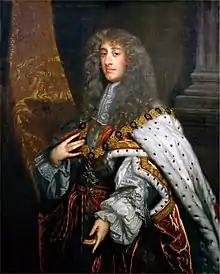 |
Prince James The Duke of York KG (1633–1701) |
1660 | 1673 | [11] |
 |
King Charles II (1630–1685) |
1673 | 1673 | |
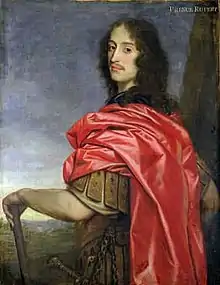 |
Prince Rupert The Duke of Cumberland KG PC FRS (1619–1682) |
1673 | 1679 | |
| In commission :[12] William Brouncker, 2nd Viscount Brouncker Sir Thomas Lyttleton |
?1679 | ?1684 | ||
 |
King Charles II (1630–1685) |
1684 | 1685 | |
 |
King James II (1633–1701) |
1685 | 1688 | |
.jpg.webp) |
King William III (1650–1702) |
1689 | 1689 | |
 |
Arthur Herbert 1st Earl of Torrington (c. 1648–1716) |
1689 | 1689 | |
 |
Thomas Herbert 8th Earl of Pembroke KG PC (c. 1656–1733) |
1701 | 1702 | |
 |
Prince George The Duke of Cumberland KG PC (1653–1708) |
1702 | 28 June 1707 | |
Lord High Admirals of Great Britain
Before 1707, a separate office of Lord High Admiral existed for Scotland. Following the Act of Union 1707, all jurisdictions were placed under the office of Lord High Admiral of Great Britain.
| Portrait | Name (birth–death) |
Term of office | Ref | |
|---|---|---|---|---|
 |
Prince George The Duke of Cumberland KG PC (1653–1708) |
28 June 1707 | 28 October 1708 | |
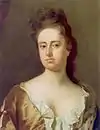 |
Queen Anne (1665–1714) |
23 October 1708 |
1708 | [11] |
 |
Thomas Herbert The Earl of Pembroke KG PC (c. 1656–1733) |
1708 | 8 November 1709 | |
.svg.png.webp) |
Office in commission | 8 November 1709 | 31 December 1800 |
|
Lord High Admirals of the United Kingdom
| Portrait | Name (birth–death) |
Term of office | Ref | |
|---|---|---|---|---|
.svg.png.webp) |
Office in commission | 1 January 1801 | 10 May 1827 |
|
 |
Prince William Henry The Duke of Clarence (1765–1837) |
10 May 1827 |
19 September 1828 |
[13] |
.svg.png.webp) |
Office in commission | 19 September 1828 |
1 April 1964 |
[14] |
 |
Queen Elizabeth II (born 1926) |
1 April 1964 |
10 June 2011 |
[15] |
 |
Prince Philip The Duke of Edinburgh (born 1921) |
10 June 2011 |
Incumbent | [5] |
Former command flags
Tudor Period
.jpg.webp) First command Flag of the Lord Admiral of England (1554–1558) under Mary I and Philip II when on board a ship.
First command Flag of the Lord Admiral of England (1554–1558) under Mary I and Philip II when on board a ship..svg.png.webp) First command Flag of the Lord Admiral of England under Henry VIII, Edward VI and Elizabeth I (1545–1553, 1559–1603) when on board a ship.
First command Flag of the Lord Admiral of England under Henry VIII, Edward VI and Elizabeth I (1545–1553, 1559–1603) when on board a ship..svg.png.webp) First command Flag of the Lord Admiral of England (1603–1625) under James VI and I when on board a ship.
First command Flag of the Lord Admiral of England (1603–1625) under James VI and I when on board a ship.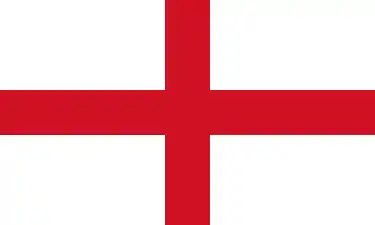 Second command Flag of the Lord Admiral of England (1545–1625) when on board a ship.
Second command Flag of the Lord Admiral of England (1545–1625) when on board a ship.
The earliest known instructions given to the Lord Admiral to fly command flags were given by King Henry VIII in 1545 the Lord Admiral was ordered to fly the flag of the arms of the King on the top of the main masthead with the flag of the cross of Saint George on the top of the front (fore) masthead.[16]
See also
- Lord High Admiral of Scotland
- Lord High Admiral of the Wash
- Lord High Admiral of Sweden
- List of the First Lords of the Admiralty
References
- "Lord High Admiral's Divisions takes place at BRNC | Royal Navy". www.royalnavy.mod.uk. Ministry of Defence, 2 May 2014. Retrieved 24 August 2017.
- Durston, Gregory (2017). The Admiralty Sessions, 1536-1834: Maritime Crime and the Silver Oar. Cambridge Scholars Publishing. p. 4. ISBN 9781443873611.
- Dear, edited by I.C.B.; Kemp, Peter (2007). "Lord High Admiral". The Oxford companion to ships and the sea (2nd ed.). Oxford: Oxford University Press. ISBN 9780199205684.CS1 maint: extra text: authors list (link)
- "The Duke of Edinburgh Appointed Lord High Admiral". royal.gov.uk. Retrieved 4 May 2017.
- "Prince Philip receives Navy title for 90th birthday". BBC News. Retrieved 4 April 2017.
- Houbraken, Jacobus; Thoyras, Paul de Rapin; Vertue, George (1747). The History of England, A List of Admirals of England, 1228-1745. J. and P. Knapton. p. 271.
- Schomberg, Isaac (1802). Naval Chronology: Or, An Historical Summary of Naval & Maritime Events, from the Time of the Romans, to the Treaty of Peace, 1802. T. Egerton. p. 188.
Sir Nicholas Tamworth, Admiral of the North.
- Schomberg, Isaac (1802). Naval Chronology: Or, An Historical Summary of Naval & Maritime Events, from the Time of the Romans, to the Treaty of Peace, 1802. T. Egerton. p. 188.
Sir Nicholas Tamworth, Admiral of the North.
- Schomberg, Isaac (1802). Naval Chronology: Or, An Historical Summary of Naval & Maritime Events, from the Time of the Romans, to the Treaty of Peace, 1802. T. Egerton. p. 188.
Sir Nicholas Tamworth, Admiral of the North.
- Schomberg, Isaac (1802). Naval Chronology: Or, An Historical Summary of Naval & Maritime Events, from the Time of the Romans, to the Treaty of Peace, 1802. T. Egerton. p. 188.
Sir Nicholas Tamworth, Admiral of the North.
- National Archives, Kew, ref. ADM 4/410 List of the Lords High Admiral and Commissioners for executing that Office, which have been appointed since the year 1660 (1915)
- "No. 1485". The London Gazette. 9 February 1679. p. 2.
- "No. 18360". The London Gazette. 11 May 1827. p. 1033.
- "No. 18506". The London Gazette. 19 September 1828. p. 1733.
- "No. 43288". The London Gazette. 3 April 1964. p. 2895.
- Perrin, W. G. (William Gordon) (1922). "Flags of Command". British flags, their early history, and their development at sea; with an account of the origin of the flag as a national device. Cambridge, England: Cambridge : The University Press. p. 77.
Sources
- Houbraken, Jacobus. Thoyras, Paul de Rapin. Vertue, George. (1747). The History of England, A List of Admirals of England (1224-1745). England. Kanpton. P and J.

